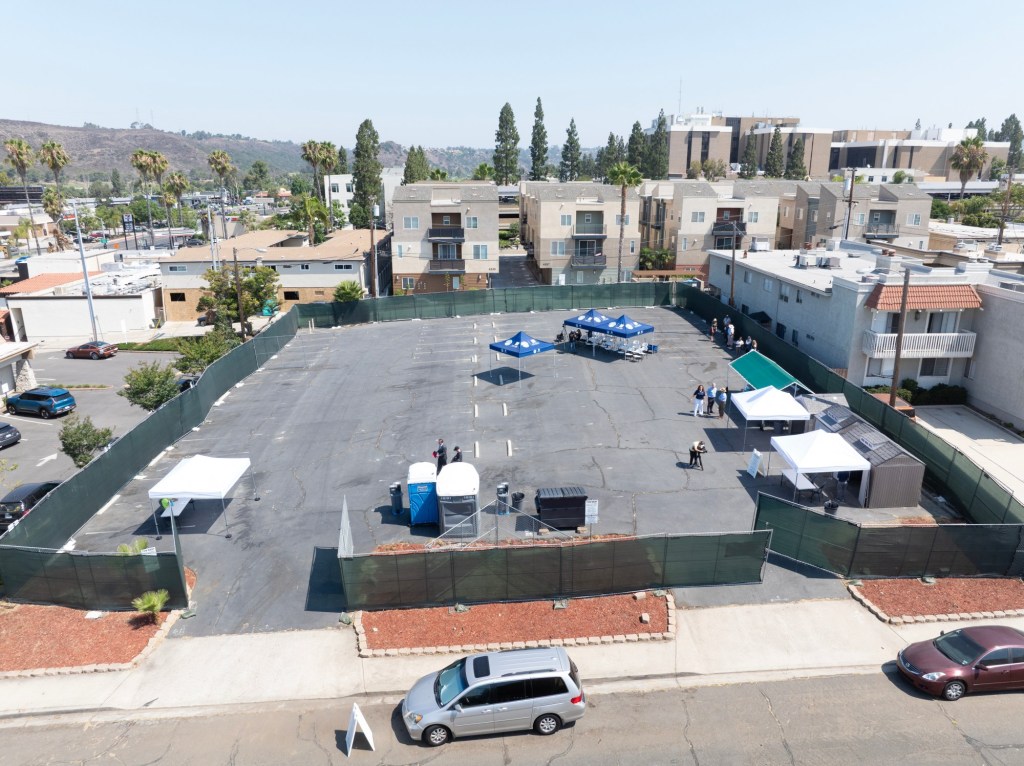Amid a swirl of headlines about federal officials shrinking the social safety net, Melissa Peterman knew her budget was vulnerable.
Peterman is executive director of Townspeople, a San Diego nonprofit that helps residents escape homelessness. A little more than half of its funding comes from the federal government. Yet last month she learned that decisions made in Sacramento, not Washington D.C., will likely force Townspeople to slim down a program that connects homeless individuals with roommates.
“I really thought that if we were going to experience any sort of funding cuts, it would be at the federal level, not the state,” Peterman said.
Homelessness service organizations across San Diego County are navigating turbulent waters for reasons that often have little to do with President Donald Trump.
San Diego’s Rosecrans homeless shelter closed last month after the city and county, both of which face deficits, couldn’t agree on who should pay for what. An outreach team focused on tough cases may shut down next year because of budget cuts in the city. And the county cancelled a contract to distribute naloxone, a nasal spray that reverses opioid overdoses, in the wake of possible financial mismanagement. (The District Attorney’s Office is now looking into how the Harm Reduction Coalition managed that contract and county officials said they’re still giving out naloxone, which is often known by the brand name Narcan.)
It’s difficult to say exactly how much the region spends on homelessness. While there are receipts for, say, shelter stays — the city of San Diego spent around $42 million on short-term beds during the last fiscal year — there’s no easy way to add up hidden costs like clean-up crews scrubbing sidewalks or the police patrolling encampments. Many projects depend on money from multiple sources, a method called braided funding, and the loss of any one can lead to complicated ripple effects throughout an entire organization.
Townspeople’s shared housing program relies on almost $600,000 from California’s Homeless Housing, Assistance and Prevention initiative, or HHAP, Peterman said. The money covers a range of expenses, including staff that help homeless people find housing and mediate conflicts between new roommates. But California’s wrestling with its own deficit and the current state budget has no new HHAP funding. Peterman now believes the money will run out by September.
The roommate program should continue in Vista, since that city appears willing to foot the bill, Peterman added. But Townspeople may have to lay off employees serving other parts of the county.
To be sure, all of these changes could soon look minor if Trump re-shapes how homelessness is addressed nationwide. In July, the president issued an executive order titled “Ending Crime and Disorder on America’s Streets” that, at first glance, promises a wholesale reimagining of the government’s response to the crisis.
The directive calls for camping bans, a crackdown on open drug use and the “civil commitment of individuals with mental illness.” Housing First policies, which focus on getting people under a roof before other problems are addressed, are on the chopping block. So is harm reduction, a strategy that aims to keep people with substance use disorders alive until they can receive treatment.
“President Trump’s executive order is a wake-up call,” San Diego County Supervisor Jim Desmond, a Republican and longtime critic of Housing First, said in a statement. “California’s leaders need to stop protecting the status quo and start following through with real solutions that restore order, dignity, and hope.”
But a close read of the directive invites uncertainty about what’s actually being called for.
Every city in San Diego County already has a camping ban. Are those what the president wants?
California’s Senate Bill 43 and CARE Court have in recent years made it easier to detain people with mental illnesses. Is that enough?
Furthermore, is the administration targeting all harm-reduction initiatives, including the distribution of Narcan? Or is the Trump Administration only after “safe consumption” sites where people are allowed to use illegal drugs — sites that don’t appear to exist in San Diego County?
“There are a helluva lot of question marks,” said Walter Bishop, the city of San Diego’s director of government affairs.
Representatives for San Diego County and the Regional Task Force on Homelessness similarly said they were still sorting out how Southern California might be affected. Leaders at the National Alliance to End Homelessness noted that answers may not come until federal agencies figure out how to implement the order.
Even if everyone on the street suddenly agreed to accept services, it’s not clear where they would go. Shelters are regularly full and supplies of detox beds are lacking.
“Where are we putting people?” Mary Frances Kenion, the national alliance’s chief equity officer, said during a recent press call. “There’s already a shortage on high-quality care.”
All the while, outreach teams, case managers and other aid workers continue to use what they have to serve the thousands of people countywide who sleep outside.
On Thursday morning, several elected leaders gathered in San Diego’s Grantville neighborhood to announce the launch of a new safe-parking lot where homeless residents can sleep in their vehicles.
The project required cooperation between two political parties and three levels of government. U.S. Rep. Sara Jacobs, a Democrat, helped round up $850,000 in federal funding. The lot is owned by the county, which pulled in Republican Supervisor Joel Anderson, while the surrounding area is represented on the San Diego City Council by Raul Campillo, a Democrat.
Twenty parking spots are available and six households were scheduled to move in on Thursday evening.
“Bipartisanship is not dead,” Jacobs told the crowd.
